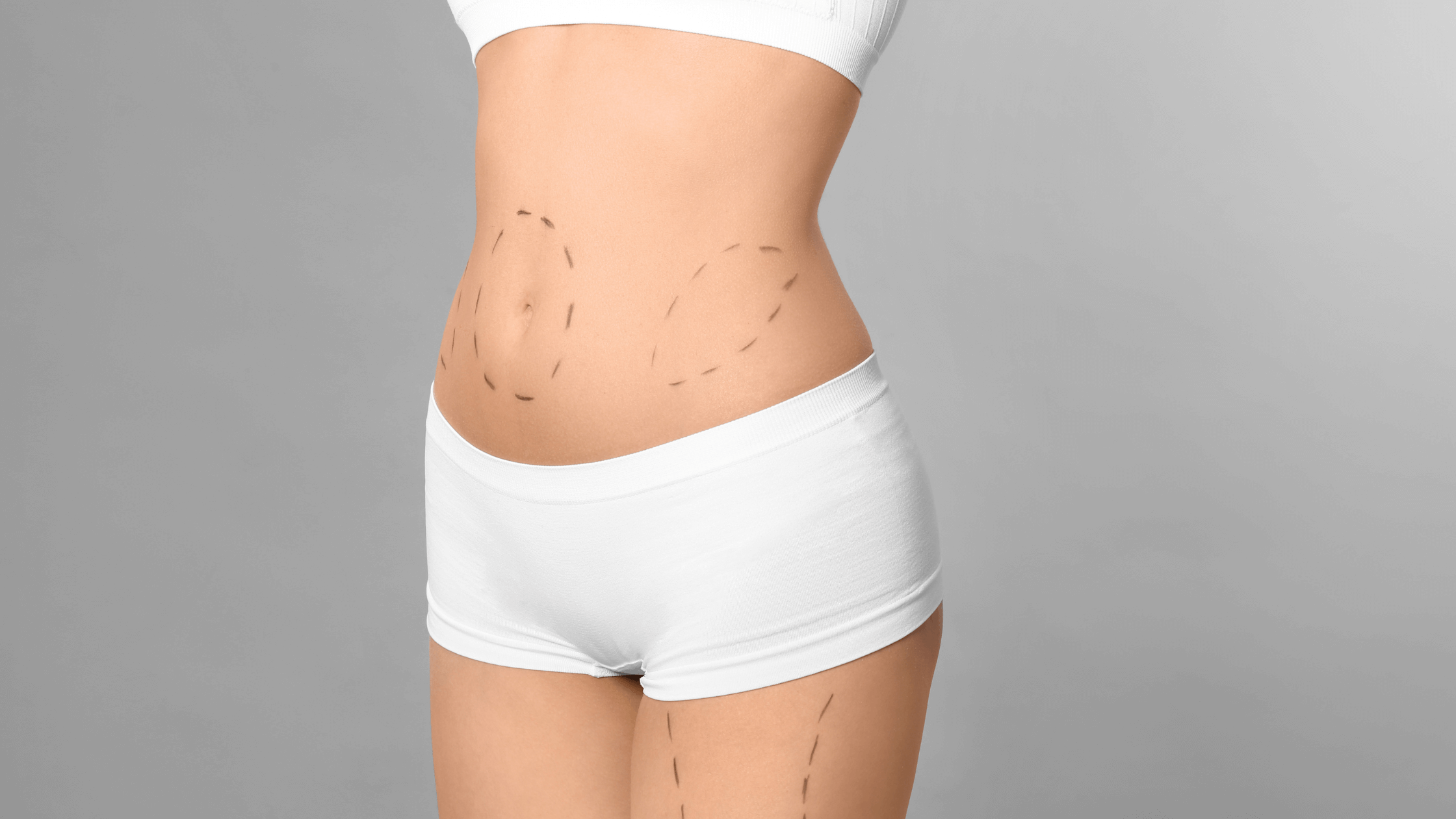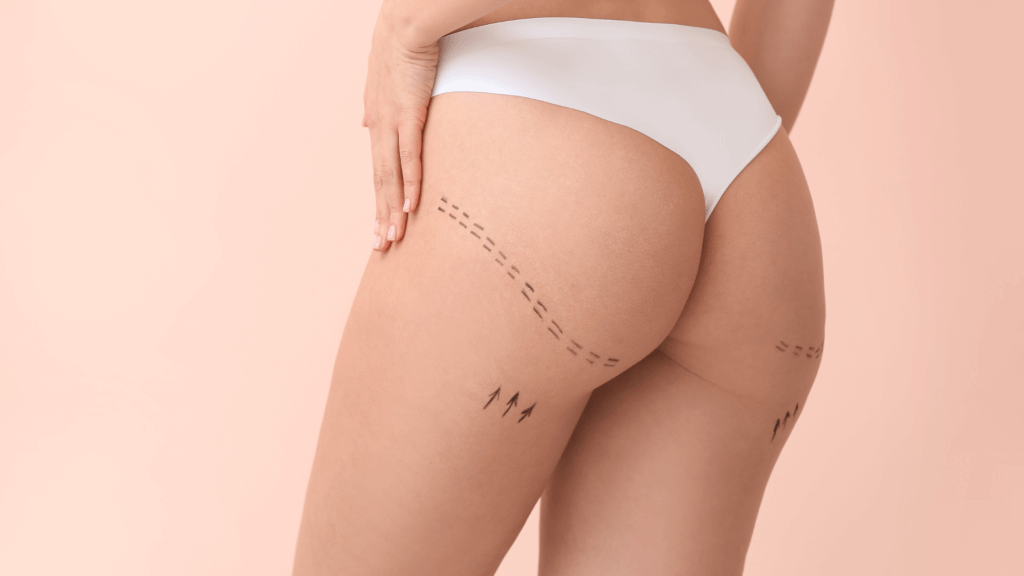
Aesthetica Editorial Team

Have you ever caught your reflection and thought, “Well, gravity really does its job, huh?”
If sagging buttocks and excess skin have become unwanted guests who have overstayed their welcome, a lower body lift might be the eviction notice you need to serve.
This plastic surgery procedure isn’t just a mere ‘nip and tuck’. It’s a game-changer that can give your body a rejuvenating boost and restore a youthful, perky silhouette. From saggy bums to flappy tummy folds, we’ll dive into how a lower body lift can send these party crashers packing!
So, sit tight (pun intended) as we unravel the ins and outs of this transformative procedure, how it tackles gravity’s pull, and why it might be your next step to feeling fab in your own skin!
What is a Lower Body Lift?
A lower body lift is a cosmetic surgery designed to help improve the shape and tone of your body’s underlying tissue by removing excess sagging fat and skin.
Now, you might be wondering, “where exactly is this ‘lower body’ you’re talking about?” When we talk about a lower body lift, we’re focusing on the abdomen area, the buttocks, the groin, and the outer thighs. Picture everything from your belly button down to about mid-thigh!
The lower body lift is popular with patients who’ve experienced dramatic weight loss, since it tightens up loose or saggy areas. The same goes for natural effects of aging, sun damage, or even pregnancies, where skin elasticity and tone can take a hit.
On average, starting from our mid-thirties, we bid goodbye to about 5% of our muscle mass every decade. And yes, this takes a toll on the contour of our buttocks, too!
Source: Prevention.com

How Does a Lower Body Lift Tighten Sagging Buttocks?
Imagine your body is like a well-tailored suit. Over time, if the suit isn’t cared for, the material can stretch, sag, or lose its shape.
In your body’s case, factors such as aging, weight loss, or pregnancies can make the ‘material’ — your skin and underlying tissues — lose their elasticity. In particular, your backside might start to droop or sag.
Now, here comes the lower body lift — the tailor of your body! The plastic surgeon makes an incision, usually around the waist or lower — around where you’d wear a belt. This is sometimes called a belt lipectomy.
With the incision made, the surgeon then lifts up the skin and fat layer. This gives them access to the underlying tissues that support your buttocks. This is the part where the tightening happens!
The surgeon pulls these tissues upward, and then secures them in this ‘lifted’ position. This is what gives the buttocks a firmer, perkier appearance.
Once the tissues are all tightened and secured, the surgeon will then remove any excess skin. The incision is then stitched up, taking care to minimize the visibility of any scarring.
As your body heals, you’ll begin to see the full effects of the surgery — a tighter, perkier buttocks, and, hopefully, a boost in your confidence, too!
Did you know that 8,433 lower body lift procedures were performed in the U.S. in 2020?
Source: American Society of Plastic Surgeons
What is the Role of a Lower Body Lift in Excess Skin Removal?
Your skin is like a super stretchy suit that adjusts to accommodate all the changes your body goes through. But when you lose a lot of weight, especially quickly, your skin might not have enough time to catch up and shrink back down. The result? Excess, sagging skin.
After all the weight is gone, the lower body lift comes in to tidy up the leftover mess — the excess skin.
The process involves a surgeon making an incision around the waist. Through this incision, they can pull up and remove the excess skin from your abdomen, hips, back, buttocks, and thighs. Picture it like pulling up baggy pants and then trimming away the extra fabric to make them fit better.
Once the excess skin has been removed, the surgeon then tightens the remaining skin and sutures the incision closed. The end result? A smoother, firmer lower body contour!
Recovery and Results: What to Anticipate After Your Lower Body Lift
Lower Body Lift Recovery
After the surgery is done, you’ll wake up in a recovery area with bandages applied to your incisions. You might also have small, thin tubes placed under your skin to help drain any excess blood or fluid. Don’t worry, your surgeon will have them removed after a few days.
You might feel sore, swollen, and there might be some discomfort during the first few days after surgery. But don’t worry, your surgeon will provide you with pain medication to make things easier. They’ll also advise you on how to best position yourself while sitting or lying down to help minimize pain.
You’ll likely need to wear a compression garment for a few weeks to help reduce swelling and support your new body contours while you heal. It’s not the most glamorous part of the process, but it’s super important!
Lower Body Lift Results
Patience is key when it comes to seeing your dream results.
While you might notice changes soon after surgery, the final results may take several months to a year to fully show as your body gradually adjusts and the post-surgical swelling decreases.
The incisions from a lower body lift can leave scars, but your surgeon will make them as inconspicuous as possible. You can also help by following your doctor’s advice on scar care to promote healing.
Remember, your new look is here to stay, provided that you maintain a stable weight and general fitness. Significant weight fluctuations can affect your results, so keeping a healthy lifestyle is important.
How to Care for Your Lower Body Lift Scars
Scarring is a normal part of the healing process after any surgery.
Your surgeon will create the incisions in places where the scars can be easily hidden by clothing. But, it’s also up to you to take good care of those scars to help them fade over time.
Keep your scars clean and dry as soon as you’re out of surgery. Your surgeon will provide you with specific instructions on how to clean your incisions — follow them to the letter!
Avoid any strenuous activity or anything that puts pressure on the incision sites for the first few weeks. Basically, take it easy and let your body heal properly!
Once your surgeon gives the go-ahead, you can start applying a silicone-based scar gel to your scars to speed up the fading process. Remember to apply it consistently and according to the product’s instructions for optimal results.
Sunscreen is another must-have in your scar care toolkit. The sun can make scars darker and more noticeable, so try to keep the incision areas covered or use a high-SPF sunscreen when you’re out and about.
Stay hydrated and maintain a healthy diet. What you eat and drink can actually affect how your scars heal! Foods rich in protein, vitamin C, and zinc support wound healing. Staying well-hydrated helps maintain skin elasticity, aiding the healing process.
Lastly, patience is key. Scars can take many months or even up to a year or more to fully mature and fade. Don’t get discouraged if your scars don’t disappear as quickly as you’d like. It’s a slow process, but with good care, you can help your scars become less noticeable over time.
The process of fading can stretch out over a year or even more, but typically, most folks won’t notice any additional lightening of their scars after reaching the two-year milestone.
Source: www.austin-weston.com

Making the Decision: Is a Lower Body Lift Right for You?
A lower body lift can be a great option for patients who have lost a significant amount of weight and are left with excess, sagging skin around their abdomen, hips, buttocks, and thighs.
Maybe you’ve lost weight through diet and exercise, or perhaps you’ve had bariatric surgery. Either way, if the leftover skin is bothering you and affecting your comfort or self-confidence, a lower body lift might be a valuable option for you!
Another important factor is your overall health. Surgical procedures like this are major, so you need to be in optimal health to minimize risks and complications. That means no serious medical conditions that could impair healing, and if you’re a smoker, you’ll have to quit for a while, as it will mess with the healing process.
By ditching the smokes 4 to 6 weeks before your surgery and maintaining the smoke-free streak for another 4 weeks post-operation, you can slash your chances of facing wound-related complications in half.
Source: Facs.org
You should also reach a stable weight. If you’re planning to lose a lot more weight or if you’re considering getting pregnant, it might be better to hold off on the surgery.
Consider your willingness to accept minimal scarring. While surgeons hide the scars, they are an inevitable part of the process.
Lastly, think about whether you’re ready for the recovery process. It can take several weeks or more to fully recover from a lower body lift, and you’ll need to follow your surgeon’s post-op instructions carefully to ensure the best possible outcome.
So, is a lower body lift right for you? It’s a very personal decision that you should make with input from a qualified plastic surgeon. They can help you weigh up the pros and cons based on your specific circumstances and goals!
Schedule Your Lower Body Lift Consultation!
Ready to embark on your lower body lift journey? Meet us at 19500 Sandridge Way, Suite 350, Leesburg, VA 20176, or call us at (703) 574-4342 for a complimentary consultation with Board-Certified Plastic Surgeon Dr. Phillip Chang before moving forward with your procedure! If everything matches up, our team will help you navigate the entire process from beginning to end! Also, remember to check out our blog and social media for more information on plastic surgery and plastic surgery trends!
References
2020 Plastic Surgery Statistics Report – American Society of Plastic …, www.plasticsurgery.org/documents/news/statistics/2020/plastic-surgery-statistics-full-report-2020.pdf. Accessed 12 Jul. 2023.
“Belt Lipectomy.” JHM, 19 Nov. 2019, www.hopkinsmedicine.org/health/treatment-tests-and-therapies/belt-lipectomy#. Accessed 12 Jul. 2023.
DiDio, Larysa. “My Butt Keeps Going South as I Age-Help!” Prevention, Prevention, 5 Apr. 2022, www.prevention.com/fitness/fitness-tips/a20457381/my-butt-keeps-going-south-as-i-age-help/. Accessed 12 Jul. 2023.
“Quit Smoking before Your Operation.” ACS, www.facs.org/for-patients/preparing-for-your-surgery/quit-smoking/. Accessed 12 Jul. 2023.
Austin-Weston. “What Is the Healing Process for Plastic Surgery Scars?” Reston, VA Plastic Surgery, Austin-Weston, The Center for Cosmetic Surgery, 8 Dec. 2020, www.austin-weston.com/blog/what-is-the-healing-process-for-plastic-surgery-scars#. Accessed 12 Jul. 2023.
Let Us Help You!
Our office can provide you with helpful information, schedule a free consultation, and walk you through the many services and procedures we provide.
Contact Dr. Chang's Office:
More Articles For You

The Latest Techniques in Double Chin Removal in Leesburg, VA
In the charming town of Leesburg, VA, where looking good and feeling great are top

The Art of Refining the Side Profile of a Woman through Plastic Surgery
In the realm of cosmetic enhancements, the side profile of a woman holds a pivotal

Enhance Now, Pay Later: Plastic Surgery Payment Plans in Leesburg, VA
In the picturesque town of Leesburg, VA, pursuing beauty and self-improvement is a journey many

Areola Reduction for Men in Loudoun County
In the heart of Loudoun County, where the beauty of nature meets bustling urban life,
